by Enzo Coccia
Often, talking to someone we use the expression “Don’t you understand me? Do I speak Arabic?” when the speaker fails to understand the idea that you would like to express.
Many months ago, the New York journalist Daniel Young asked me what I thought about a new way of conceiving the pizza “a canotto”(dinghy pizza). Imagine the context: I do not speak English, he does neither speak Italian nor the Neapolitan pizzaioli jargon.
If we start thinking about the meaning of the word canotto, since I was little, I meant a small inflatable boat made of plastic or rubber-based fabric. I would have never thought that one day I would refer to a style of pizza as a dinghy. I simply claimed that it is inappropriate for me to call this type of pizza with this name, but I have never criticized this pizza, as the Neapolitan pizza has always been represented by different ways to hand stretch the dough. Moreover, I did not even know the word BULLSHIT nor its meaning until this morning, I asked my son to explain it to me because, as I wrote, neither I speak English nor Daniel Young speaks Italian.
Leaving my house this morning, I was thinking about a possible dialogue with my porter Nunziatina: “If you come to the pizzeria and you order some pizzas tonight, how do you like them? Pizza canotto? “Obviously, the seventy-year-old porter would answer: “Enzo, what are you saying?”.
From a traditional and historical point of view there were neighborhoods in the city of Naples where the pizzas were made in different styles. What does it mean? Some pizzerias for example in Vomero district (as Napoleone, Il ragno d’oro) and some restaurants-pizzerias tended to prepare a pizza with a high crust and smaller diameter (the outer edge). On the other hand, in the poorer areas (as Mercato Pendino, Quartieri Spagnoli, San Lorenzo Vicaria, Porto, etc)in order to give the impression to make a bigger pizza at the same price the pizzaioli tended to stretch the dough out until the disc became thin and soft. “Doppi e past”, “ a ruot e carrett” or “fin e scorz” or “fin e past” were the expressions used to define them.
Far be it from me to offend or hurt the professionalism of my colleagues from Caserta and its province and the new generations of pizzaioli. It is okay to prepare a highly hydrated pizza with a swollen crust, which is the clear sign of digestibility, but “canotto” is an inappropriate and banal term to call it.
Extrapolating one word from an entire conversation without a clear context and without neither having a cultural-historical note as reference nor verifying the veracity of it goes against the fact-checking journalism ethics, an Anglo-Saxon journalistic word that indicates the act of checking factual statements and datas in a text or a speech. Today in the digital and social media era the act of fact-checking has totally disappeared.
I would have much liked to have been informed, before publishing his post, by Pignataro, a professional which I think highly of and I have known for a long time, and to have been asked what I had essentially said to Daniel Young.
To Mrs Nunziatina, my porter, I would reply “the most important thing is that the pizza is delicious and tastes good tonight”.




















